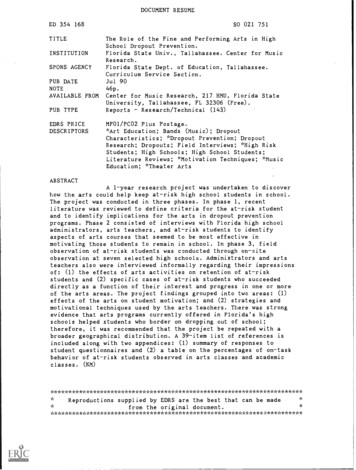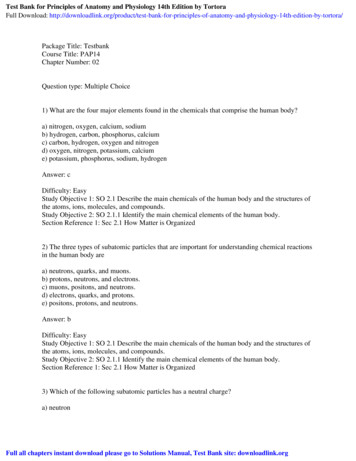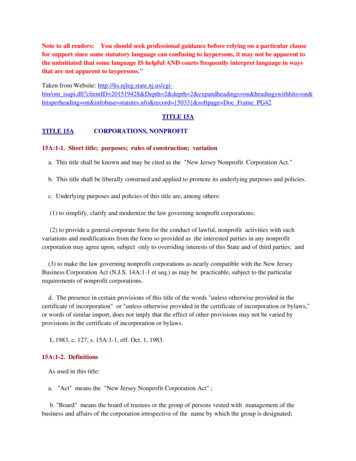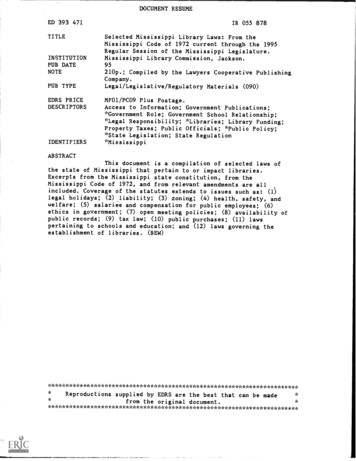
Transcription
DOCUMENT RESUMEED 354 168TITLEINSTITUTIONSPONS AGENCYPUB DATENOTEAVAILABLE FROMPUB TYPEEDRS PRICEDESCRIPTORSSO 021 751The Role of the Fine and Performing Arts in HighSchool Dropout Prevention.Florida State Univ., Tallahassee. Center for MusicResearch.Florida State Dept. of Education, Tallahassee.Curriculum Service Section.Jul 9046p.Center for Music Research, 217 HMU, Florida StateUniversity, Tallahassee, FL 32306 (Free).Research/Technical (143)ReportsMF01/PCO2 Plus Postage.*Art Education; Bands (Music); DropoutCharacteristics; *Dropout Prevention; DropoutResearch; Dropouts; Field Interviews; *High RiskStudents; High Schools; High School Students;Literature Reviews; *Motivation Techniques; *MusicEducation; *Theater ArtsABSTRACTA 1-year research project was undertaken to discoverhow the arts could help keep at-risk high school students in school.The project was conducted in three phases. In phase 1, recentliterature was reviewed to define criteria for the at-risk studentand to identify implications for the arts in dropout preventionprograms. Phase 2 consisted of interviews with Florida high schooladministrators, arts teachers, and at-risk students to identifyaspects of arts courses that seemed to be most effective inmotivating those students to remain in school. In phase 3, fieldobservation of at-risk students was conducted through on-siteobservation at seven selected high schools. Administrators and artsteachers also were interviewed informally regarding their impressionsof: (1) the effects of arts activities on retention of at-riskstudents and (2) specific cases of at-risk students who succeededdirectly as a function of their interest and progress in one or moreof the arts areas. The project findings grouped into two areas: (1)effects of the arts on student motivation; and (2) strategies andmotivational techniques used by the arts teachers. There was strongevidence that arts programs currently offered in Florida's highschools helped students who border on dropping out of school;therefore, it was recommended that the project be repeated with abroader geographical distribution. A 39-item list of references isincluded along with two appendices: (1) summary of responses tostudent questionnaires and (2) a table on the percentages of on-taskbehavior of at-risk students observed in arts classes and academicclasses. *************************Reproductions supplied by EDRS are the best that can be madefrom the original ******************************
THE ROLE OFTHE FINE AND PERFORMING ARTSIN HIGH SCHOOL DROPOUT PREVENTIONU.S. DEPARTMENT OF EDUCATIONOffice of Educational R01101IrCh and improvementEDUCATIONAL RESOURCES INFORMATIONCENTER (ERIC)his document has been reproduced asreceived from the person or organizationoriginating 1C Minor charges have been made to improvereproducl on qualityPoints of view or opinions staled in thisdocu-ment do not necessarily represent officialOE RI position or policyi"PERMISSION TO REPRODUCE THISMATERIAL HAS BEEN GRANTED BYTO THE EDUCATIONAL RESOURCESINFORMATION CENTER (ERIC).-A Curriculum Development and Renewal Projectdeveloped by the Center for Music Researchfor the Florida Department of Education,Division of Public Schools.July, 1990BEST COPY AVAILABLE2
2Copyright, State of Florida,Department of State, 1990.These materials may bereproduced for educationalpurposes.Copies of this document are available fromthe Center for Music ResearchFlorida State UniversityTallahassee, Florida 32306-2098A Curriculum Development andRenewal Project developed by theCenter for Music Research for theFlorida Department of Education,Division of Public Schools,Bureau of Elementary and Secondary Education,Curriculum Service Sectionti
3TABLE OF CONTENTSAcknowledgements5Forward: Letter from Betty Castor, Commissioner of Education6Summary of the Role of the Fine and Performing Arts in High School Dropout PreventionOverviewRationaleThe projectResultsEffects of the arts on student motivationStrategies and motivational techniquesused by the arts teachersRecommendations88911111315The Role of the Fine and Performing Arts in High School Dropout PreventionPurpose/goals18Phase 1: Review of research on students at riskStatus of the researchResearch related to the arts and dropout preventionThe arts and the learning styles of at-risk students18Phase 2: Interviews with administrators, arts teachersand at-risk studentsAdministrator surveysTeacher surveysStudent surveysPhase 3: Field observations of arts teachersat-risk studentsConclusionsReferences18202021212224262729
4Appendix A: Summary of responses to student questionnaires1. Student responses to questionnaires2. Selected quotations about music, drama, art,and dance from student questionnairesAppendix B: Percentages of on-task behavior of at-risk studentsobserved in arts classes and academic classes334044
5ACKNOWLEDGMENTSParticipants in this project were staff members of the Center for Music Research, School ofMusic, Florida State University:Nancy H. Barry, Project CoordinatorJack A. Taylor, Director, Center for Music ResearchKimberly C. Walls, Project ResearcherJerry P. Wood, Project EditorConsultant to the project:June Hinckley, Music Specialist, Department of EducationParticipating high schools and districts:Coral Park Dade CountyMiami Northwestern Dade CountyNew World School of the Arts Dade CountySouth Miami High Dade CountyDouglas Anderson School of the Arts Duval CountyRibault - Duval CountySandalwood Duval County
FLORIDA DEPARTMENT OF EDUCATIONBetty CastorCommissioner of EducationJuly 20, 1990Dear Educator:It is a pleasure to extend my appreciation for your contributionsto At-Risk Students.As you are aware, a top priority is the improvement of graduationToward this end, Curriculum Development andrates in Florida.Renewal funds have been used to support a number of initiativesLegarding the fine arts.This research project documents the many positive contributionswhich fine arts programs can make in each student's education. Thecreativity provided by these programs pervades the overall attitudetoward school and enhances a positive self image.I'm sure this document will assist you as you design programs forAtRisk Students and I look forward to hearing about your success.SinceBetty 'torCommiBC/naTallahassee, Florida 32399An Affirmative Action/Equal Opportunity Employeroner
SUMMARY OF THE ROLE OFTHE FINE AND PERFORMING ARTSIN HIGH SCHOOL DROPOUT PREVENTION
8SUMMARY OF THE ROLE OFTHE FINE AND PERFORMING ARTS INHIGH SCHOOL DROPOUT PREVENTIONOVERVIEWRationaleStudents at risk and the arts. For some time now, arts teachers in the high schoolshave been well aware of the intensity of student interest and involvement when these youngpeople are participating in the creative processes of playing in the band or orchestra, acting ina play, singing in a chorus or other musical production, creating a painting or sculpture, orparticipating in modern dance or ballet. This enthusiasm for expressing oneself through thevarious artforms seems to be a motivating force for student attendance in these classes andfor their development of skills essential to satisfactory artistic expression.Over the years arts teachers have observed that enthusiasm for creative expression isnot limited to the bright and/or academically motivated students. Instead, it seems to haveuniversal appeal. Students with learning disabilities and motivational problems alsodemonstrate a need for creative expression. Teachers have found that enthusiasm for the artscan be observed in all student types.One particular type of student is of considerable interest to teachers, schooladministrators, parents, and the State of Florida: the so-called potential "dropout" or"at-risk" student. Florida has great concern for its school dropout rate; but, of course, allstates share this problem. Recent studies of these students have resulted in the developmentof reliable "dropout" profiles for students who run the risk of leaving school beforegraduation. These profiles include risk factors such as poor grades, dislike of school, familyproblems, lack of respect for education and authority, etc. The profiles can be used toidentify at-risk students.Participation 1Lljnalharts. Because participation in music, visual arts, drama, anddance seems to generate enthusiasm while satisfying a need for creative expression, art,teachers claim that many at-risk students not only participate in positive ways in theirclassroom activities, but also develop average to well above average achievement in artistic
9skills and expression. Furthermore, their attendance records in the arts classes are good,especially when compared to some of the other classes. If these claims appear to be justified,then it would seem that arts classes can be effective ways to reduce--and perhaps eventerminate--the at-risk student's desire to leave school. It may even be possible to transfersome of the learning environment and teaching concepts used in arts classes to other courses,with the intention of generating greater student enthusiasm and participation- -and thusperhaps reducing the dropout problems in the State of Florida.But before such actions can be taken, it is necessary to (1) objectively research thearts teachers' claims that at-risk students both attend and perform well in their classes; and ifthese claims are verified, then (2) it must be determined which aspects of the arts classesgenerate these desirable student behaviors. The present Arts and High School DropoutPrevention project was designed to investigate the first topic.The ProjectThis project was undertaken by the Center for Music Research at Florida StateUniversity as a Curriculum Development Grant for the Florida Department of Education,Division of Public Schools. The grant period was for the 1989-90 school year, and theproject progressed in three stages: review of the relevant literature on the dropout and at-riskproblems; interviews with administrators, teachers, and students; and on-site observations ofstudents.Phase 1: Recent research on the at-risk student. Related literature was reviewed inorder to: (a) define criteria for the at-risk student and (b) identify implications for the arts indropout prevention programs. The most prominent topic appearing in the literature concernsthe identification of the potential dropout or student at risk. Factors pertaining to the homeenvironment, intelligence quotients (I.Q.), history of school failures, low self esteem, andlack of involvement in school activities are consistently reported as predictors of studentswho will drop out of school. Several studies have examined specific programs and strategiesfor dropout prevention. Effective programs generally provide students with opportunities forvocational, academic, and creative success.Studies relating directly to arts and dropout prevention were not found. There are,however, many studies which seem to suggest the importance of arts participation toprograms designed to keep the at-risk student in school. These studies indicate that the artsare not merely "frills," but are essential for fulfilling the at-risk student's needs for expressionand intellectual development.,w I as it II. JIG ,IBAIliePhase 2: n rystudents. The second phase of this project consisted of interviews with secondary schooladministrators (N 28), arts teachers (N 85), and at-risk students at high schoolsk
10throughout the state of Florida. Both administrators and teachers acknowledged the apparentimpact that participation in the arts has had upon many students' decisions to remain inschool. Seventy percent of the administrators reported cases in which participation in artscourses has influenced a student to stay in school. An even higher percentage (89.5%) of thearts teachers stated that they were aware of specific cases in which participation in artscourses has influenced at-risk students to remain in school. These teachers were asked toidentify aspects of arts courses that seem to be most effective in motivating the at-riskstudent to remain in school. The most frequently mentioned aspect was the social interactionand camaraderie that conies from being identified as part of an arts group or performingensemble. Teachers also mentioned the importance of performance, the feeling of successand satisfaction derived from arts experiences, the self-esteem and self-confidence thatspring from participation in the arts, the importance of creative and expressive activities, andkeen student interest in the subject matter of arts courses.The at-risk students surveyed in this study included those presently enrolled in artscourses (N 35) and a few former at-risk students (N 5) who persisted to graduation.These students supported the conclusions of the administrator and teacher surveys regardingthe importance of arts courses to their decision to remain in school. Specific comments andsuggestions made by these students provided additional insight into ways in which artscourses can be most effective for motivating at-risk students to persist (Appendix A).Phase 3: Field observations of at-risk students. The third phase of this projectconsisted of on-site observations of at-risk students at seven selected Florida high schools.Administrators and arts teachers also were informally interviewed regarding theirimpressions of (a) the effects of arts activities on retention of at-risk students and (b) specificcases of at-risk students who succeeded directly as a function of their interest and progress inone or more of the arts areas.The at-risk students were observed in their arts classes and non-arts classes.Observations of the at-risk students revealed more consistent on-task behavior during artsclasses (83.9%) than during the non-arts courses (73.3%). These students were more easilydistracted in the non-arts courses; and although some of them
20.07.1990 · School Dropout Prevention. INSTITUTION Florida State Univ., Tallahassee. Center for Music. Research. SPONS AGENCY Florida State Dept. of Education, Tallahassee. Curriculum Service Section. PUB DATE. Jul 90 NOTE 46p. AVAILABLE FROM Center for Music Research, 217 HMU, Florida State. University, Tallahassee, FL 32306 (Free). PUB TYPE Reports .








![Last or Business First [Maiden] Page Title Notes](/img/1/saukcity125thjubilee-20historical-20album-index.jpg)

![[Code of Federal Regulations] [Title 21, Volume 8 .](/img/2/21-cfr-part-820.jpg)
